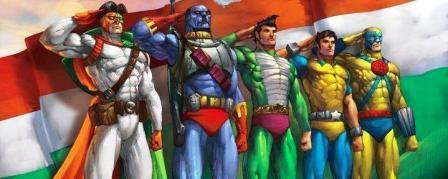




As time passed, Queen Lalita started getting depressed for not having a child of her own. The king realised the cause of her depression and became upset as well. The couple used to pray to their family deity Dev Kaljayi for his blessings. Dev Kaljayi also knew of their grievances, so one day he blessed them to have a great child. His blessings came true as the queen soon became pregnant and the whole kingdom rejoiced, except for Nagpasha. The birth of this child meant the loss of the throne for him, so he decided to kill the child before he was born.
One day when the queen was going to pray to Deva Kaljayi, Nagpasha replaced the curtained plate of her offerings to the god with one containing a dead mongoose. The Snake God got angry and knocked her unconscious with his venomous breath. The king sought forgiveness from the Devta and pleaded with him to cure his wife, to which the Devta refused. Then the desperate king tried to commit suicide. Not able to withstand a devotee's death, Deva Kaljayi showed him a way to save the queen's life. He gave a crystal to the king and told him to treat it with the queen's medicine. The crystal would divert all the poison from the queen's body to the child's body. However, due to the ill effects of the poison. the queen would lose her fertility.
The kingdom was highly grieved, as was the king. Nagpasha was overjoyed that he was now the sole heir to the throne. When the child was born, everyone believed him dead because his whole body was blue and showed no signs of life. As per Hindu rituals, the newborn baby was thrown into the river.
Nagpasha rejoiced and went to Deva Kaljayi the deity that also protected the grand royal treasure in form of a giant twoheaded snake, and asked him to hand over the royal treasures, telling him that now he was the sole heir to the throne, so the treasure rightfully belonged to him. Deva Kaljayi refused and told him that the "real successor" to the throne was alive and when the time comes the treasure will be handed over to him. Enraged, Nagpasha raised his sword against the deity only to be thrown away by a mere flick of the giant snake's tail. Nagpasha fell upon two bowls, one containing the highly toxic venom (halahal,the greatest form of venom as believed by Hindus) which destroyed his face and mixed with his blood, and the other containing Amrit, which made him immortal. Simultaneous effects of both made Nagpasha an immortal, venomous man. At that time, Nagpasha could not tolerate the changes in his body and fainted.
When the king was informed of the happenings by Dev Kaljayi, he realised that his son was not dead and he also realised the potential dangers to his son's life. So he ordered his faithful astrologer Vedacharya, who had great knowledge of Tilism to enclose the treasure in a Tilism which could be broken only by his son. Vedacharya made the tilism with the cooperation of Dev Kaljayi to ensure that no one, except for the king's son, will be able to break the tilism, not even immortal Nagpasha. When Nagpasha came to his senses, he realised that he had lost the treasure. Enraged, he murdered the king and the queen.
The child, floating away on the river in his state of suspended animation, got stuck somewhere in bushes. He laid there for a long time.
Meanwhile, the snake deity Deva Kaljayi appeared in the dreams of King Maniraj and his wife Queen Manika, rulers of ageless Ichchhadhaari naags, living secretly on an invisible island in the Indian Ocean called Nagdweep. He told them the location of the baby and asked them to cure him. They did so and discovered that the baby was far more venomous than the greatest snake on Nagdweep, which was Mahatma Kaaldoot, indicating that he had divine venom of the god. Initially, the raj vaid was unsure whether he would be able to cure the child, but since Dev Kaljayi himself asked the king for his treatment, he was assured that the treatment will work. According to the rules, no one was permitted to bring an outsider to the island, so the king decided to keep his presence a secret.
Many years passed and the treatment started showing results and, although still in the suspended animation, the color of the baby had gradually changed to green. The king gave the news to the queen and they decided to adopt the child, since they had no child of their own. Their decision was heard by Vishandhar, an evil Tantrik who wanted to become the ruler of the island, but was afraid of Mahatma Kaaldoot. He attacked the secret area where the baby was kept and escaped with him, but fearing the wrath of the god, he decided not to kill the baby and instead placed him back into the same bushes in the river where he was found. His plan failed as the queen soon got pregnant and gave birth to a daughter who was named Visarpi.
Vishandhar never knew that the baby that he left astray was cured enough to regain his senses. First, his face and later, his whole body, turned normal color and he started crying. A priest of the nearby temple located him and gave him to Professor Nagmani, who was wandering in the nearby forest searching for snakes. For unknown reasons, the priest narrated a fake story that the child belonged to a woman, who was a devotee of the Snake God. He also said that the child was blessed by an ichchhadhari naag, so he asked Nagmani to bring up the child and allows him to avenge his mother.
Nagmani realised that the priest was lying, but he took the child. The blood tests of the child showed that the child had minute, microscopic snakes in his blood, filling in for white blood cells. The child had extraordinary healing powers and was extremely venomous. He raised the baby, who became Nagraj.
Nagraj was presented to the world as a creation of Professor Nagmani. He was meant to be an ultimate killing machine, and his original plan was to hire out Nagraj to the highest bidder among villains and terrorist groups of the world.
Professor Nagmani used him for his other experimental projects and leased him for international terrorism. Nagmani always claimed that Nagraj's powers were evolved by feeding him bits of snake poison until his blood itself became poison. He claimed that his venom was a result of snake bites from 1,000 different species of snakes (This echoes the Indian legends of poisonmen or women, specifically raised to kill by their kiss) and his other powers evolved when he was treated with ashes of a dead ichchhadhaari snake. In reality, Nagraj was much more poisonous than any species of snakes because his venom was celestial.
Based largely on the Hindu myth of the shape shifting snake, Nagraj derives most of his powers from microscopic snakes that live in his bloodstream, in lieu of white blood cells. He has a number of powers, such as superhuman strength, poisonous breath, poisonous breath and poisonbite, instant healing powers, and snakes that come out of his wrists. The snakes can come out individually or form into ropes, parachutes, and many others, depending on his imagination. His venom is believed to be far stronger than Potassium Cyanide, resulting in the melting of any living being's body if he bites them or vice versa.
For his first mission, he was sold for a sum of $1 million and was to recover an ancient statue. Nagraj succeeds, but then is foiled by the Sage Baba Gorakhnath, who frees him from the mind control of Professor Nagamani. Waking up to a newer world amid the calmness of Gorakhnath, Nagraj takes a vow to eliminate terrorism from the world and works toward achieving this goal.
